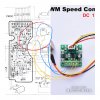Follow along with the video below to see how to install our site as a web app on your home screen.
Note: This feature may not be available in some browsers.
Have a service manual for this model but it does not look like its my pcb in it. I also have a manual for the model 222 that has an xlr on the front panel. Tried to attach the pdfs but not working. Will try againYep it does look diffo.
Do you have the schematic.
Is RM04 the pitch control that is there today? Thanks Im trying to understand but think I feel a bit lostThe cassette speed control looks fairly complicated, but I spose the recorder is a higher end one, and motor speed control is a critical part of the system to avoid wow & flutter.
Looks like the board for the tape motor is seperate, 'PM00'. There is a chip that looks like it an amp of some kind QM01, looks like theres a fine tuning pot on this.
Only guessing but I'd say that chip QM08 is the main speed control, probably a phase or frequency locked loop, it gets pulses from QM07 some kind of pulse generator either in the motor itself or on the deck somewhere, the phase locked loop will adjust the sped voltage output to match the frequency of the pulse generator with that of a built in oscillator.
Without actual chip numbers its not possible to go any further, also the chip numbers may well be house coded devices as theres no specific info on the schematic.
You could try adjusting RM04, mark the original position first, and see how much control that has and whether its enough, I suspect it will not have much range, you might be able to increase its range by replacing RM03, the only thing is if you change RM03 for too small a value you might blow the chip.









Oops thats doing things by proxy, I'd not thought you only want the motor running when the deck is playing.
Thank you for the great ideas!Oops thats doing things by proxy, I'd not thought you only want the motor running when the deck is playing.
One way to solve that is to put a relay across where the old motor connects and use that to switch power to the speed controller, powering another speed controller from the old motor supply isnt a good idea.
However your reasoning with the speed control mods for other models is sound, give that a try, the resistor inline with the speed calibration pot is a good place to adjust speed, range must be enough to make it worthwhile.
And even if you did blow up the decks speed control you always have the backup solution of using the Pwm speed controller already mentioned, another way of switching power to the motor is to find on the deck where the motor start contacts are, when you press the play button there will be some contacts mechanically pressed to start the motor and electronics.

